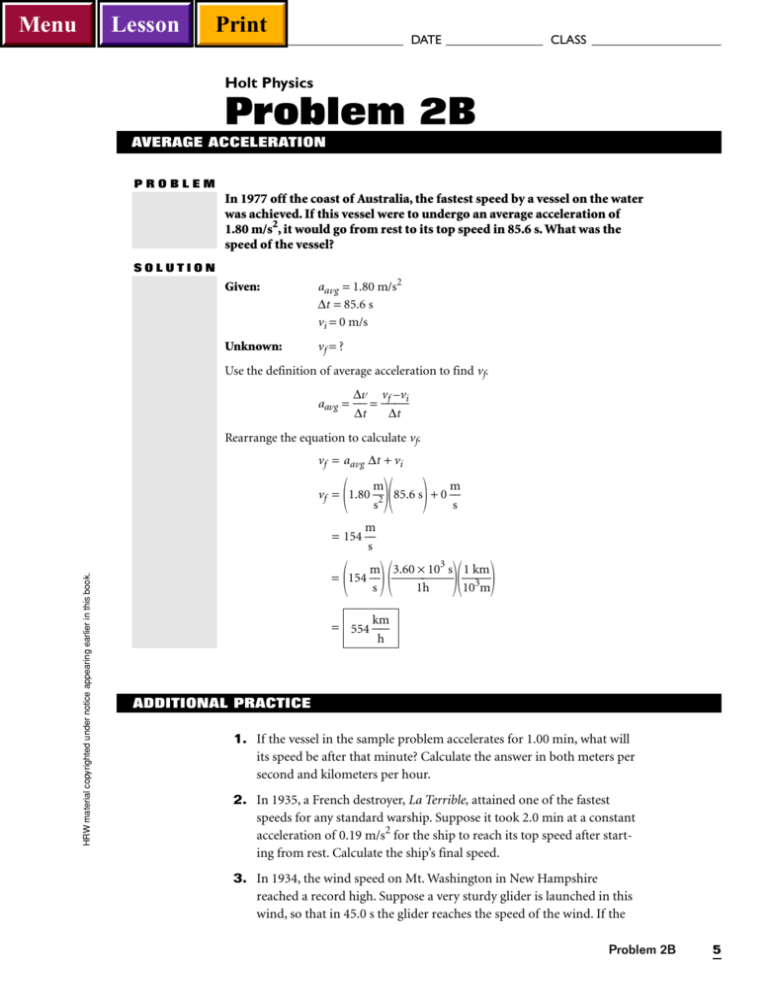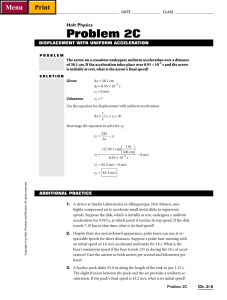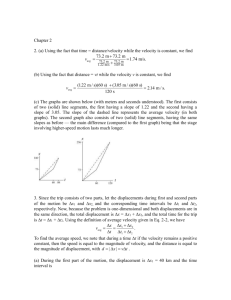
Lesson
Menu
Print
NAME ______________________________________ DATE _______________ CLASS ____________________
Holt Physics
Problem 2B
AVERAGE ACCELERATION
PROBLEM
In 1977 off the coast of Australia, the fastest speed by a vessel on the water
was achieved. If this vessel were to undergo an average acceleration of
1.80 m/s2, it would go from rest to its top speed in 85.6 s. What was the
speed of the vessel?
SOLUTION
Given:
aavg = 1.80 m/s2
∆t = 85.6 s
vi = 0 m/s
Unknown:
vf = ?
Use the definition of average acceleration to find vf.
∆v
aavg = =
∆t
vf – vi
∆t
Rearrange the equation to calculate vf.
vf = aavg ∆t + vi
m
m
vf = 1.80 2 85.6 s + 0
s
s
HRW material copyrighted under notice appearing earlier in this book.
m
= 154
s
m 3.60 × 103 s 1 km
= 154 3
10 m
s
1h
km
= 554
h
ADDITIONAL PRACTICE
1. If the vessel in the sample problem accelerates for 1.00 min, what will
its speed be after that minute? Calculate the answer in both meters per
second and kilometers per hour.
2. In 1935, a French destroyer, La Terrible, attained one of the fastest
speeds for any standard warship. Suppose it took 2.0 min at a constant
acceleration of 0.19 m/s2 for the ship to reach its top speed after starting from rest. Calculate the ship’s final speed.
3. In 1934, the wind speed on Mt. Washington in New Hampshire
reached a record high. Suppose a very sturdy glider is launched in this
wind, so that in 45.0 s the glider reaches the speed of the wind. If the
Problem 2B
5
Menu
Lesson
Print
NAME ______________________________________ DATE _______________ CLASS ____________________
glider undergoes a constant acceleration of 2.29 m/s2, what is the
wind’s speed? Assume that the glider is initially at rest.
4. In 1992, Maurizio Damilano, of Italy, walked 29 752 m in 2.00 h.
a. Calculate Damilano’s average speed in m/s.
b. Suppose Damilano slows down to 3.00 m/s at the midpoint in his
journey, but then picks up the pace and accelerates to the speed
calculated in (a). It takes Damilano 30.0 s to accelerate. Find the
magnitude of the average acceleration during this time interval.
5. South African frogs are capable of jumping as far as 10.0 m in one hop.
Suppose one of these frogs makes exactly 15 of these jumps in a time
interval of 60.0 s.
a. What is the frog’s average velocity?
b. If the frog lands with a velocity equal to its average velocity and
comes to a full stop 0.25 s later, what is the frog’s average
acceleration?
6. In 1991 at Smith College, in Massachusetts, Ferdie Adoboe ran
1.00 × 102 m backward in 13.6 s. Suppose it takes Adoboe 2.00 s to
achieve a velocity equal to her average velocity during the run. Find
her average acceleration during the first 2.00 s.
a. How long does it take to cover the 150 m?
b. What is the magnitude of the average acceleration during that
part of the course?
8. The highest speed ever achieved on a bicycle was reached by John
Howard of the United States. The bicycle, which was accelerated by
being towed by a vehicle, reached a velocity of +245 km/h. Suppose
Howard wants to slow down, and applies the brakes on his now freely
moving bicycle. If the average acceleration of the bicycle during braking is –3.0 m/s2, how long will it take for the bicycle’s velocity to decrease by 20.0 percent?
9. In 1993, bicyclist Rebecca Twigg of the United States traveled 3.00 km
in 217.347 s. Suppose Twigg travels the entire distance at her average
speed and that she then accelerates at –1.72 m/s2 to come to a complete
stop after crossing the finish line. How long does it take Twigg to come
to a stop?
10. During the Winter Olympic games at Lillehammer, Norway, in 1994,
Dan Jansen of the United States skated 5.00 × 102 m in 35.76 s. Suppose it takes Jansen 4.00 s to increase his velocity from zero to his
maximum velocity, which is 10.0 percent greater than his average velocity during the whole run. Calculate Jansen’s average acceleration
during the first 4.00 s.
6
Holt Physics Problem Workbook
HRW material copyrighted under notice appearing earlier in this book.
7. In the 1992 Summer Olympics, the German four-man kayak team covered 1 km in just under 3 minutes. Suppose that between the starting
point and the 150 m mark the kayak steadily increases its speed from
0.0 m/s to 6.0 m/s, so that its average speed is 3.0 m/s.
Menu
Lesson
Print
Additional Practice 2B
Givens
Solutions
1. vi = 0 km/h = 0 m/s
60 s
vf = aavg ∆t + vi = (1.80 m/s2)(1.00 min) + 0 m/s = 108 m/s
1 min
2
aavg = 1.8 m/s
3600 s 1 km
vf = 108 m/s = (108 m/s) 3 = 389 km/h
1 h 10 m
∆t = 1.00 min
2. ∆t = 2.0 min
60 s
vf = aavg ∆t + vi = (0.19 m/s2) (2.0 min) + 0 m/s = 23 m/s
1 min
2
aavg = 0.19 m/s
vi = 0 m/s
3. ∆t = 45.0 s
vf = aavg ∆t + vi = (2.29 m/s2)(45.0 s) + 0 m/s = 103 m/s
2
aavg = 2.29 m/s
vi = 0 m/s
4. ∆x = 29 752 m
∆t = 2.00 h
∆x
29 752 m
a. vavg = = = 4.13 m/s
∆t
3600 s
(2.00 h)
1h
vi = 3.00 m/s
∆v 4.13 m/s − 3.00 m/s
1.13 m/s
b. aavg = = = = 3.77 × 10−2 m/s2
∆t
30.0 s
30.0 s
vf = 4.13 m/s
II
∆t = 30.0 s
10.0 m
5. ∆x = (15 hops)
1 hop
2
= 1.50 × 10 m
Copyright © by Holt, Rinehart and Winston. All rights reserved.
∆t = 60.0 s
∆x 1.50 × 102 m
a. vavg = = = +2.50 m/s
∆t
60.0 s
vf − vi 0 m/s − 2.50 m/s
−2.50 m/s
= = = −1.0 × 101 m/s2
b. aavg =
∆tstop
0.25 s
0.25 m/s
∆t stop = 0.25 s
vf = 0 m/s
vi = vavg = +2.50 m/s
6. ∆x = 1.00 × 102 m, backward
= −1.00 × 102 m
∆t = 13.6 s
∆t = 2.00 s
∆x −1.00 × 1 02 m
vavg = = = −7.35 m/s
∆t
13.6 s
vf − vi −7.35 m/s − 0 m/s
aavg = = = 3.68 m/s2
2.00 s
∆t
vi = 0 m/s
vf = vavg
7. ∆x = 150 m
vi = 0 m/s
vf = 6.0 m/s
vavg = 3.0 m/s
∆x
150 m
a. ∆t = = = 5.0 × 101 s
vavg 3.0 m/s
vf − vi 6.0 m/s − 0 m/s
b. aavg = =
= 0.12 m/s2
∆t
5.0 × 101
Section Two — Problem Workbook Solutions
II Ch. 2–3
Menu
Lesson
Print
Givens
Solutions
8. vi = +245 km/h
103 m
= +68.1 m/s
1 km
aavg = −3.0 m/s2
km 1 h
vi = 245
h 3600 s
vf = vi −(0.200) vi
vf = (1.000 − 0.200) vi = (0.800)(68.1 m/s) = +54.5 m/s
vf − vi 54.5 m/s − 68.1 m/s
−13.6 m/s
∆t = =
= 2 = 4.5 s
2
− 3.0 m/s
aavg
−3.0 m/s
9. ∆x = 3.00 km
∆t = 217.347 s
aavg = −1.72 m/s2
vf = 0 m/s
10. ∆x = +5.00 × 102 m
∆t = 35.76 s
vi = 0 m/s
II
∆t = 4.00 s
3
∆x 3.00 × 10 m
vi = vavg = = = 13.8 m/s
217.347 s
∆t
vf − vi 0 m/s − 13.8 m/s
−13.8 m/s
tstop = =
= 2 = 8.02 s
2
−1.72 m/s
−1.72 m/s
aavg
∆x
5.00 × 102 m
vf = vmax = (1.100)vavg = (1.100) = (1.100) = +15.4 m/s
∆t
35.76 s
15.4 m/s − 0 m/s
∆v vf − vi
aavg = = = = + 3.85 m/s2
4.00 s
∆t ∆t vmax = vavg + (0.100) vavg
Additional Practice 2C
1. ∆x = 115 m
vi = 4.20 m/s
(2)(115 m)
2∆x
(2)(115 m)
∆t = = = = 25.0 s
vi + vf
4.20 m/s + 5.00 m/s
9.20 m/s
vf = 5.00 m/s
2. ∆x = 180.0 km
vi = 3.00 km/s
2∆x
360.0 km
(2)(180.0 km)
∆t = = = = 1.2 × 102 s
vi + vf
3.00 km/s
3.00 km/s + 0 km/s
3. vi = 0 km/h
vf = 1.09 × 103 km/h
∆x = 20.0 km
(2)(20.0 × 103 m)
2∆x
a. ∆t = =
vi + vf
1 h 1000 m
(1.09 × 103 km/h + 0 km/h)
3600 s 1 km
40.0 × 103 m
∆t = = 132 s
1h
1000 m
(1.09 × 103 km/h)
3600 s 1 km
∆x = 5.00 km
vi = 1.09 × 103 km/h
(2)(5.00 × 103 m)
2∆x
b. ∆t = =
vi + vf
1 h 1000 m
(1.09 × 103 km/h + 0 km/h)
3600 s 1 km
vf = 0 km/h
10.0 × 103 m
∆t = = 33.0 s
1h
1000 m
(1.09 × 103 km/h)
3600 s 1 km
II Ch. 2–4
Holt Physics Solution Manual
Copyright © by Holt, Rinehart and Winston. All rights reserved.
vf = 0 km/s








